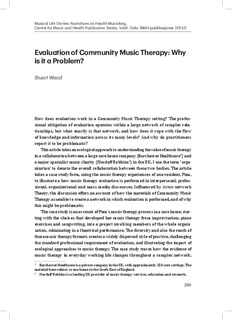| dc.description.abstract | How does evaluation work in a Community Music Therapy setting? The professional obligation of evaluation operates within a large network of complex relationships, but what exactly is that network, and how does it cope with the flow of knowledge and information across its many levels? And why do practitioners report it to be problematic? The case study is an account of Pam’s music therapy process in a care home, starting with the choices that developed her music therapy from improvisation, piano exercises and songwriting, into a project involving members of the whole organisation, culminating in a theatrical performance. The diversity and also the reach of these music therapy formats creates a widely dispersed style of practice, challenging the standard professional requirement of evaluation, and illustrating the impact of ecological approaches to music therapy. The case study traces how the evidence of music therapy in everyday working life changes throughout a complex network, incorporating an originating sense of musical purpose into thought, word, song, plot, performance, corporate morale, DVD, training resource and printed communications. The case study is prompted by my experiences as a practitioner in evaluating music therapy experiences in this context, illustrated by Pam’s process. I summarise these as problems of what, who, when and how to evaluate. I ask what to evaluate because the practice of Community Music Therapy creates a frame in which any music-making, or any activity connected to music-making, can be harnessed for health benefit. There is no rule within the literature on Community Music Therapy that marks out the territory of what counts as an acceptable mode of practice, except what falls within safe conduct according to the professional and registering bodies and the judgment of the practitioner. | nb_NO |
